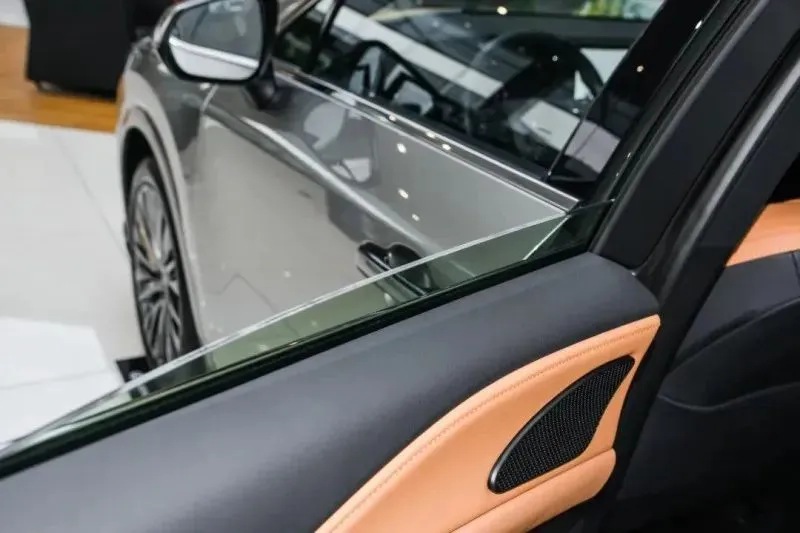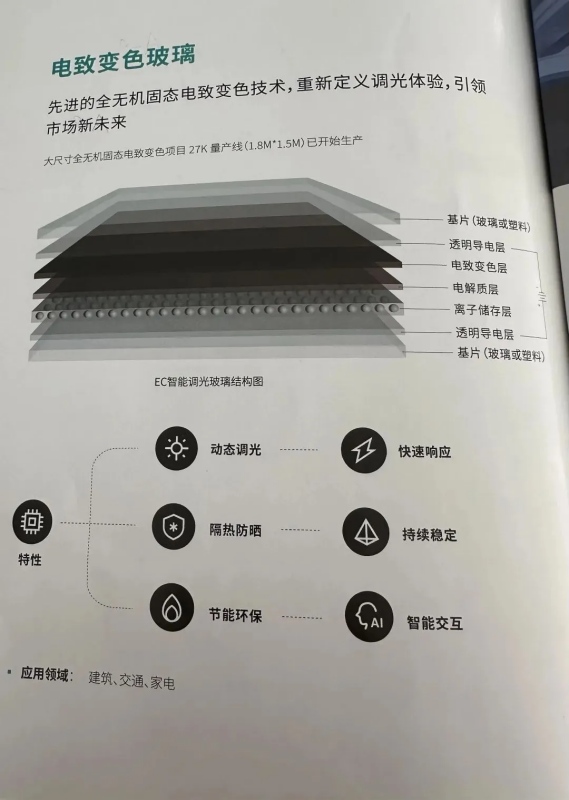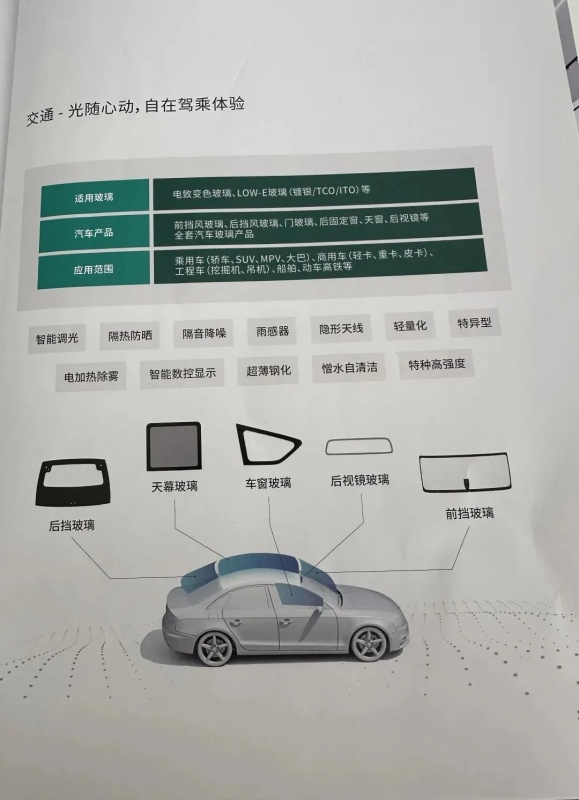
The current situation and challenges of automotive glass
As an important part of the car body, automotive glass is like the "eyes" of the car, which not only provides a clear vision for drivers and passengers, but also is a key line of defense to ensure driving safety. From the most basic windshield to the side windows and rear windows, each piece has an important mission, in the event of a collision, they can effectively block splashes, prevent drivers and passengers from being thrown out of the car, and their sturdiness is directly related to the life safety of the people in the car.

At present, the global automotive glass market continues to expand, and according to relevant data, the global automotive glass market size has reached a considerable level in 2024 and is expected to maintain a steady growth trend in the next few years. In this huge market, companies such as Fuyao Glass, Aijiexu (Japan), Plate Glass (Japan), and Saint-Gobain (France) occupy a dominant position. Taking Fuyao Glass as an example, as a leading enterprise in China's automotive glass industry, it has a high market share in the global market, with revenue of 28.314 billion yuan in the first three quarters of 2024, a year-on-year increase of 18.84%; The net profit was 5.479 billion yuan, a year-on-year increase of 32.79%, and the sales proportion of high value-added products continued to increase, which promoted the rapid growth of the company's performance.
However, the seemingly thriving automotive glass industry also faces a number of challenges. At the technical level, although the current automotive glass has made significant progress in terms of safety performance, heat and sound insulation, etc., with the rapid development of the automotive industry, especially the rise of new energy vehicles and intelligent vehicles, higher requirements have been put forward for automotive glass. For example, the pursuit of lightweight new energy vehicles to improve the mileage, which requires automotive glass to ensure the strength at the same time, as far as possible to reduce the weight, at present, some companies in the lightweight glass technology research and development has made progress, but has not completely broken through the technical bottleneck, can not be applied on a large scale.
From the perspective of market competition, the competition in the industry is fierce, and price wars occur from time to time. In order to compete for market share, some enterprises adopt low-price strategies, resulting in compressed product profit margins, which to a certain extent affects the investment of enterprises in research and development, and then hinders the technological innovation and product upgrading of the industry. Moreover, the homogenization of automotive glass products on the market is more serious, and the products of many enterprises are not much different in function and quality, lack of unique competitive advantages, and are difficult to meet the increasingly diverse needs of consumers.
In terms of environmental protection, the automotive glass industry is also facing a lot of pressure. On the one hand, energy consumption and emissions in the production process need to be further reduced to meet increasingly stringent environmental regulations. On the other hand, the recycling and reuse of end-of-life automotive glass is also an urgent problem to be solved. At present, the automotive glass recycling system is not perfect, the recycling efficiency is low, and a large number of scrapped glass has not been effectively recycled, which not only causes waste of resources, but also causes certain pollution to the environment.
Technological breakthroughs lead to change
Intelligent upgrades
Swept by the wave of intelligence, automotive glass is making great strides in the direction of intelligence. As a typical representative of it, dimming glass has a rapid development momentum. Taking electro-variable tonal glass as an example, it can change the light transmittance of the glass through current control, and when the sunlight is strong, it can instantly switch to a dark state, effectively blocking ultraviolet rays and strong light, and creating a comfortable environment for the car. And when the light is low, it can quickly become transparent to ensure a good field of vision. Some high-end models, such as the Tesla Model X, are equipped with dimming glass sunroofs, which allow owners to adjust the light transmittance of the sunroofs at any time according to their own needs, greatly improving the driving experience.
Head-up display (HUD) glass is also an important embodiment of automotive glass intelligence. It projects key information such as vehicle speed and navigation directly onto the windshield, allowing the driver to easily access information without having to look down at the dashboard, thereby focusing more attention on the road conditions and greatly improving driving safety. For example, in some BMW models, the HUD glass not only displays clearly, but also links with the vehicle's intelligent driving assistance system to adjust the display content in real time according to road conditions and driving modes, providing drivers with a more intelligent and convenient driving experience.
In addition, glass antenna technology is gradually maturing. It integrates the antenna in the car glass, making the car look more simple and beautiful, and at the same time, it can effectively reduce signal interference and improve the stability of signal reception. Some new energy vehicle brands, such as some models of BYD, have adopted glass antenna technology to achieve efficient communication between the vehicle and the outside world, providing strong support for the realization of intelligent network functions.

Lightweighting is essential for the automotive industry, not only to reduce energy consumption, but also to improve vehicle handling. In the field of automotive glass, weight reduction is achieved mainly through reducing the thickness of glass and adopting new materials.
At present, some car manufacturers have begun to experiment with thinner glass. For example, the traditional 5 mm thick windshield was reduced to 4 mm or even thinner, which effectively reduced the weight of the glass without sacrificing safety performance. According to relevant data, for every 1 mm reduction in the thickness of automotive glass, the weight of the whole vehicle can be reduced by about 10 kilograms, and the fuel consumption can be reduced by about 0.06 liters per 100 kilometers, which can significantly improve the mileage of new energy vehicles.
The application of new materials also brings new opportunities for automotive glass lightweighting. Polycarbonate (PC) materials are ideal for lightweight automotive glass due to their high strength and low density. For example, the rear triangular window of the Toyota 86 GRMN Sports Car Special Edition is made of PC plexiglas and uses plasma coating technology, which reduces weight by 50% compared to traditional glass, while also improving durability and wear resistance. Although there are still some deficiencies in the anti-wear performance and weather-resistant performance of PC materials, with the continuous progress of technology, these problems are expected to be solved, and the application prospects of PC materials in the field of automotive glass are very broad in the future.
Multi-functional fusion
Today's automotive glass is no longer limited to the basic function of sheltering from wind and rain, but is developing in the direction of multi-functional integration, integrating sound insulation, heat insulation, ultraviolet protection, self-cleaning and other functions, bringing users a full range of high-quality experience.
Acoustic glass can effectively reduce the noise in the car and create a quiet and comfortable space for drivers and passengers. It usually has a multi-layer structure with a soundproof material sandwiched in between, which can block outside noise from entering the car. Like some luxury brand cars, such as the Mercedes-Benz S-Class, the window glass uses advanced sound insulation technology, even at high speeds, the interior of the car can remain relatively quiet, so that passengers can enjoy a peaceful journey to the fullest.
Through a special coating process, the insulating glass can effectively reflect infrared rays, reduce heat entering the car, reduce the load of air conditioning in the car, and achieve the purpose of energy saving and emission reduction. For example, Fuyao's ultra-insulating glass can block 87% of infrared rays, which can effectively reduce the temperature in the car, reduce the energy consumption of air conditioning, and save energy costs for users.
UV-resistant glass blocks more than 99% of UV rays, protecting the skin of the occupants from UV rays, while also preventing the aging and fading of interior trim materials due to UV exposure. Most automotive glass on the market has some UV protection, and some high-end models have better performance in this regard, providing users with more comprehensive protection.
Self-cleaning glass uses photocatalytic or nanotechnology to automatically clean dirt on the surface under the action of sunlight and rain, keeping the glass clean and transparent. Although the application of self-cleaning glass is not widely used at present, with the continuous maturity of technology and the reduction of cost, it is expected to be applied in more models in the future, saving users the trouble of cleaning glass frequently.
Market demand drives development

New demand for new energy vehicles
The vigorous development of new energy vehicles has brought new opportunities and challenges to the automotive glass industry. Different from traditional fuel vehicles, new energy vehicles have more urgent requirements for lightweight due to the limitation of battery mileage. As an important part of the body, the lightweight of automotive glass is crucial to improve the endurance of new energy vehicles. Therefore, the research and development and application of lighter, thinner, and high-strength glass materials have become an important development direction of the industry.
The high degree of intelligence of new energy vehicles also puts forward higher requirements for automotive glass. For example, in order to enable autonomous driving functions, automotive glass needs to have higher light transmittance to ensure that sensors and cameras can clearly perceive the external environment. At the same time, it also needs to have good thermal insulation to reduce the risk of failure of the electronic equipment in the car due to excessive temperatures. In addition, users of new energy vehicles also have higher requirements for comfort in the car, and automotive glass needs to perform better in sound insulation and heat insulation to create a quiet and comfortable driving environment for users.
According to the prediction of relevant market research institutions, with the continuous expansion of the market share of new energy vehicles, the demand for automotive glass for new energy vehicles will show a rapid growth trend in the next few years. This will bring huge market opportunities for automotive glass companies, prompting them to increase investment in technology research and development, and launch more high-performance glass products that meet the needs of new energy vehicles.
Shifts in consumer demand
With the improvement of people's living standards and the change of consumption concepts, consumers' demand for cars is no longer limited to basic travel functions, but pays more attention to the comfort, safety and aesthetics of cars. This shift in demand has also had a direct impact on the development direction of automotive glass.
In terms of comfort, consumers expect automotive glass to effectively isolate noise and heat from the outside world, providing a quiet and cool space in the car. Therefore, products such as soundproof glass and heat-insulating glass are more and more favored by consumers. Some high-end models even use multi-layer acoustic glass and smart insulated glass to further enhance the comfort of the car.
Safety is always a key concern for consumers. As an important component to ensure driving safety, the strength and reliability of automotive glass are crucial. In addition to traditional tempered glass and laminated glass, some glass products with higher safety performance have gradually entered the market, such as anti-splash glass, bulletproof glass, etc. In the event of an impact, these glasses can effectively prevent glass shards from splashing and protect the safety of people in the car.
Aesthetics is also one of the important factors for consumers to consider. Nowadays, the design of automotive glass is becoming more and more diverse, not only traditional clear glass, but also coated glass in various colors and patterns, privacy glass, etc. These glasses not only meet the needs of consumers for personalization, but also enhance the overall aesthetics of the car.
&nb
Name: Litong Glass
Mobile:+86 16632961602
Tel:+86 16632961602
Email:vip@litongglass.com
Add:Shahe city,Hebei,China